Log in or create new account to save this product to your wishlist.
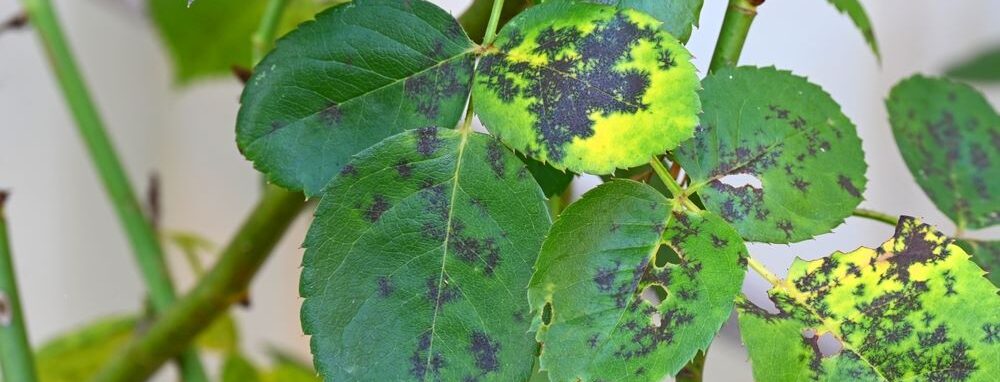
How to Prevent and Treat Rose Black Spot: A Comprehensive Guide
Roses are beautiful additions to any garden, but they can be susceptible to a fungal infection known as rose black spot. Find out how to identify, treat, and prevent this common plant disease.
🌱 All important maintenance moments for your lawn during the year. Leave your email and we will send you the lawn calendar for free.
Enter your email
Receive the lawn calendar in the mail
Enjoy a green lawn all year round!

- Order by 2PM = shipped today
- 250.000+ satisfied customers!
- 60 day satisfaction guarantee
Roses are enchanting blooms, beloved for their beauty and fragrance. Indeed, they can liven up any garden. But they’re susceptible to various diseases, and one of the most common and troublesome is rose black spot.
- What is Rose Black Spot?
- Prevention and Control
- Treatment Options
- Disease-Resistant Roses
- FAQs
This common disease is caused by the fungus Diplocarpon rosae, and it can significantly weaken rose plants and reduce their overall health and beauty.
In this comprehensive guide, I’ll explore the causes and symptoms of black spot on roses and effective prevention and treatment methods. Follow these guidelines to improve the health and longevity of your roses.
Ready? Let’s go.
What is Rose Black Spot?
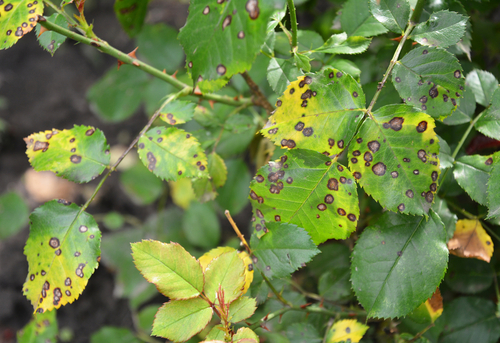
Black spot is a fungal disease affecting rose bushes, manifesting as circular black spots on the plant’s leaves. If left untreated, affected leaves will turn yellow and fall off.
However, these unsightly black spots can eventually merge and spread, causing the entire plant to lose its leaves.
Black spot can also infect young canes and flowers, leading to further damage and a decline in flower production.
The life cycle of rose black spot
Black spot develops between autumn and winter when the fungal spores grow in piles of fallen leaves and infected canes.
Then, the wind and rain spread the mature spores onto your roses’ foliage.
And this is when you’ll notice irregular black spots on the plant’s leaves and young stems, eventually leading to defoliation.
Does black spot kill a rose plant?
Black spot won’t kill the host plants during the first year or two.
However, the infection can make your roses more susceptible to other diseases if left untreated.
Symptoms of Black Spot
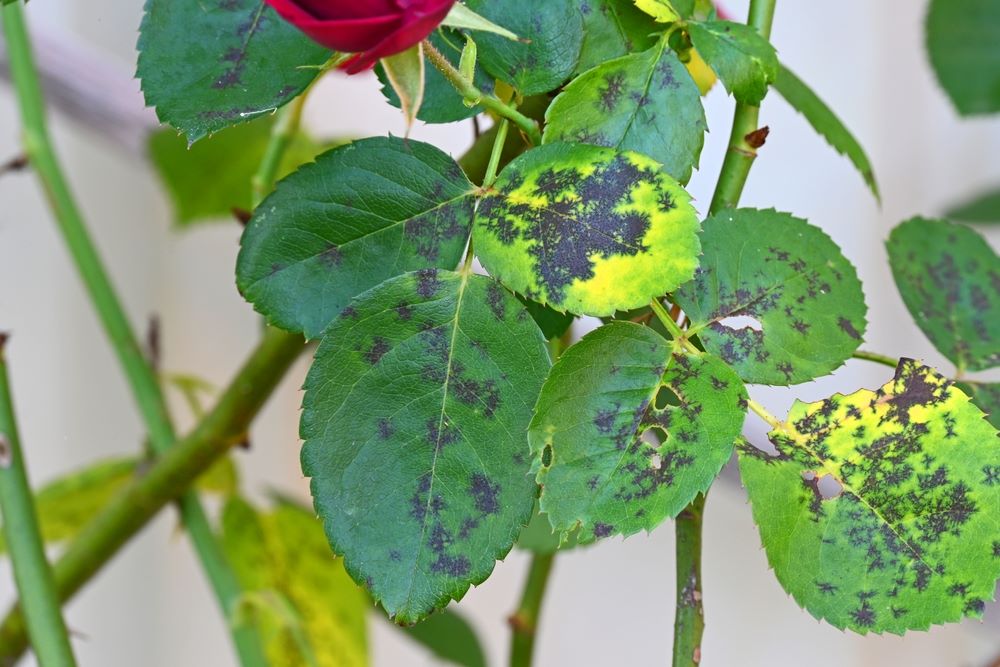
The symptoms of black spot are easily recognisable:
- Stage 1: Circular black spots — These spots with ragged or feathery edges are often surrounded by a yellow ring.
- Stage 2: Spread — As the disease progresses, the spots enlarge and eventually merge, causing the affected leaves to turn yellow and drop prematurely.
- Stage 3: Defoliation — The entire plant may lose its leaves in severe cases.
Causes of Black Spot
Black spot is caused by fungal spores that thrive in cool, moist conditions. These are primarily dispersed through splashing water from the wind and rain or manual watering.
The disease overwinters on infected fallen leaves and stems, waiting for favourable conditions to germinate in the spring.
At this stage, the spores require continuous wetness for about seven hours to germinate and infect new tissue.
And once the spores have developed fruiting bodies, called acervuli, they produce more spores that spread the disease to previously healthy plant parts.
Prevention and Control
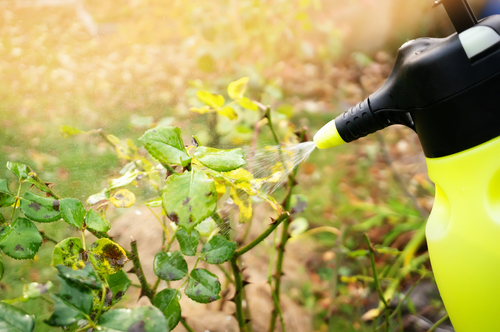
It may sound like an oxymoron, but preventing black spot from infecting your roses is the most effective way to manage the disease.
Reduce the risk of disease by implementing proper gardening practices and creating unfavourable conditions for the fungus.
Here’s how:
Ideal Growing Conditions
Creating ideal growing conditions for your roses is essential for preventing black spot.
Choose a sunny location with well-draining soil. Most rose varieties thrive in full, all-day sun, which helps dry moisture away from the leaves, preventing the development of black spot.
And remember to water your roses regularly — weekly watering is necessary to keep your plants hydrated,
But:
Avoid getting the leaves wet!
Good Air Circulation
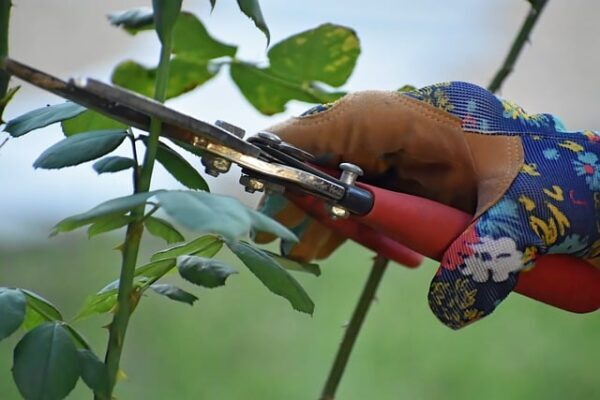
All fungal infections thrive in crowded flower beds, so good air circulation around and throughout your rose plants is crucial for preventing black spot.
So, avoid planting your roses too close to other plants, as overcrowding can hinder airflow.
If your rose bush becomes dense and prevents air from circulating, prune it to open up spaces between the canes.
By ensuring proper air circulation, you’ll make it harder for black spot to spread.
Not sure what you’re doing when you prune? No worries: check out our expert guide to pruning your roses for more information on cutting back and shaping your plants.
Proper Watering Techniques
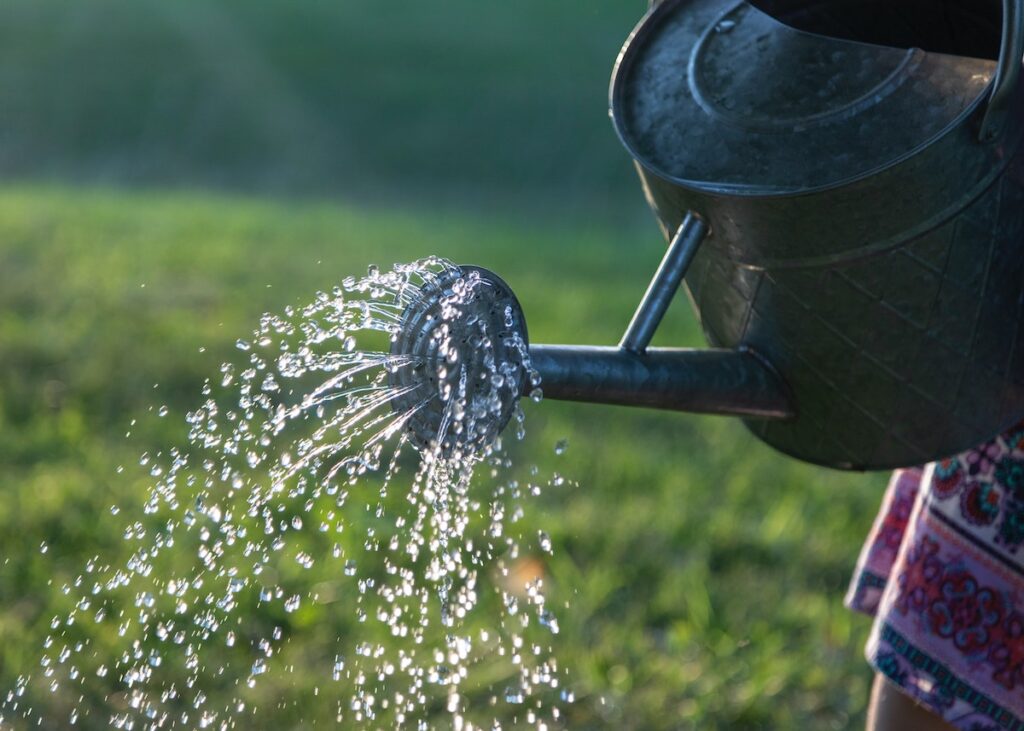
Remember, black spot is spread through water, so avoid wetting the leaves when you water your roses.
And while you can’t control rain, avoid using overhead sprinklers that wet the foliage.
Instead, focus water directly onto the soil, minimising leaf wetness – this worsens the conditions for black spot, reducing the spread and development of the infection.
Pruning and Clean-up
Pruning plays a crucial role in preventing and managing black spot. So, cut back and remove any infected leaves as soon as you notice them.
Ideally, carry out a thorough garden clean-up each autumn, removing and disposing of fallen leaves and plant debris.
This prevents the overwintering of spores, reducing the risk of reinfection in the spring.
Additionally, prune infected canes in dry weather, about 6 to 8 inches below the infection site. And disinfect your pruners with a 10 per cent bleach solution or alcohol between cuts to prevent the further spread of the disease.
Mulching
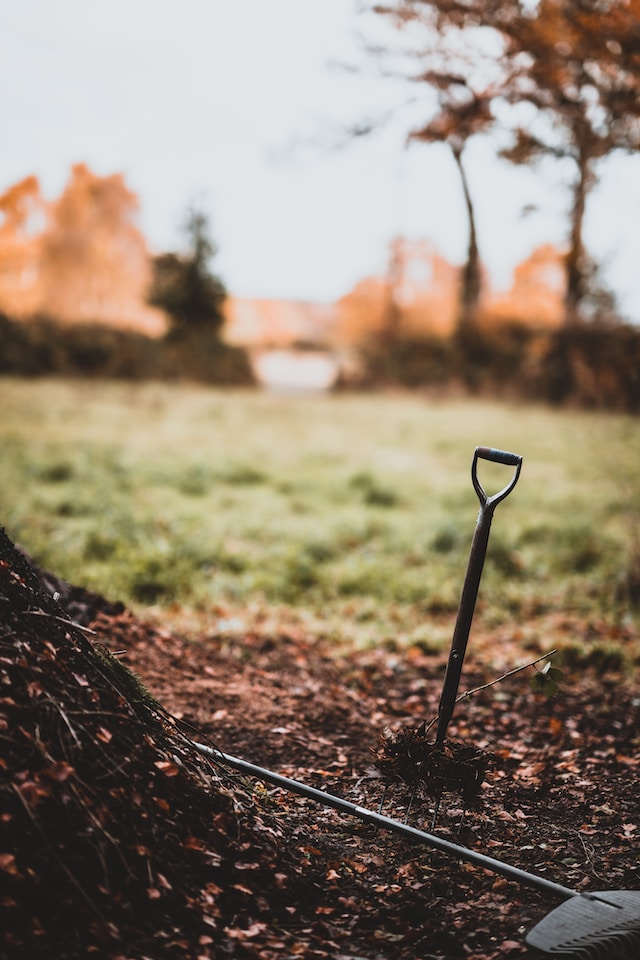
Apply a substantial layer of mulch around the plant’s base to help prevent the spread of black spot.
Mulch acts as a barrier, preventing soil from splashing onto the plant. Because if spores are present in the earth, the mulch will help stop black spot from spreading to the roses.
However:
Avoid adding rotting wood to your compost, which can create a moist environment conducive to other fungal diseases. Always apply well-rotted compost.
Treatment Options
If your roses do become infected with black spot, there are treatment options available to help manage the disease.
And while it’s challenging to eradicate black spot once it takes hold, these treatments can reduce the infection’s severity and prevent further spread:
Commercial Fungicides
There are several commercial fungicides available for treating black spot on roses. These fungicides contain active ingredients like tebuconazole, trifloxystrobin, or triticonazole, available in powder form or mixed with water and sprayed on the affected plants.
Bordeaux mix, a fungicide that contains copper sulfate and hydrated lime, is another popular option, which you can also use as a preventative treatment in the spring before the plants leaf out.
Organic Remedies
If you prefer organic or homemade treatments, there are several options to consider.
Baking soda spray is a popular choice, as it helps prevent the spread of rose black spot and offers some protection against powdery mildew:
- Add 1 teaspoon of baking soda to a litre of warm water, and add up to 1 teaspoon of liquid soap.
- Spray the mixture onto the leaves, ensuring complete coverage.
Vinegar is another organic remedy that may be effective against black spot on roses:
- Add 1 tablespoon of white distilled vinegar to a cup of water, baking soda, dish soap, and vegetable oil.
- Spray this mixture onto the rose foliage and reapply each week to 10 days, especially after rain.
Milk and hydrogen peroxide have also been reported to have some success in controlling black spot, although their effectiveness may vary.
Disease-Resistant Roses
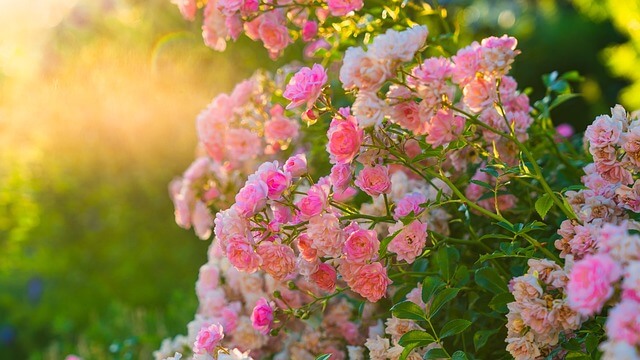
Consider planting disease-resistant rose varieties to minimise the risk of black spot and other fungal diseases.
Certain roses are naturally more resistant to black spot and can withstand the disease better than others.
For example, floribundas, shrub roses, and climbing roses are generally more resistant, while hybrid tea roses, grandifloras, and miniature roses are more susceptible.
Rugosas and roses from the Canadian Explorer series, such as ‘John Cabot’ and ‘William Baffin’, are also known for their resistance to black spot.
So, when selecting roses for your garden, look for varieties labelled as disease-resistant to ensure a healthier and more resilient rose bush.
FAQs
Rose black spot is a fungal infection causing irregular dark spots on foliage, often surrounded by a thin yellow circle. Act fast whenever you spot the problem to prevent it from spreading. Prune off infected branches and apply a fungicide containing tebuconazole, trifloxystrobin, or triticonazole. These are available in powder form, mixed with water, and sprayed on the affected plants.
Black spot is the most common rose disease, caused by a fungus that creates black spots on foliage, which eventually turns yellow and drop off. Stop the spread as soon as you spot it by pruning off infected branches and spraying with a fungicide.
The fungus that causes rose black spot is not harmful to humans, but it will do your roses a lot of damage. I recommend spraying a fungicide or home remedy, such as diluted baking soda, every week or so in early spring to prevent the condition
Any questions?
I hope I’ve provided all the answers you might have about black spot on roses, but if you have any other questions, drop us an email.
Or you could try our comprehensive Help & Advice section, for a cornucopia of garden and lawn care tips.
Thanks for reading!
-
How to Grow Eucalyptus in British GardensWith a little love and care, eucalyptus trees can thrive in English gardens. Since they don’t germinate well without proper help, there are not considered invasive. So, there is no reason not to plant them if you enjoy their looks.Read more
-
Transform Your Garden with All-Year-Round Flowering PlantsDid you know you can enjoy blooming flowers even in January? With the right selection of all year round plants, there’s no need to wait until spring to add some colour to your garden.Read more
-
How to Create a Butterfly Garden: A Simple Guide for British GardensThe UK's butterfly population includes 59 different species. These beautiful winged creatures face a steady decline because of habitat loss, pollution and changing weather patterns. Your garden can become a vital link between nature reserves and natural habitats. Let’s explore how.Read more
-
Volcanic Rock Dust for Your Garden—Application and TipsDid you know that volcanic rock dust is a brilliant organic soil improver? This article explains exactly what it's good for and how to use it properly.Read more
-
How to Use Landscape Fabric ProperlyIf weeds or erosion in your garden are troubling you, landscape fabric might be the solution. We’ll explain how and when to use it properly, just keep on reading.Read more
-
Hostas: A Complete Care GuideIf you have a north-facing garden or some shady corners on your property, hostas are the plants for you. These green delights thrive particularly well in partial to full shade and require consistently moist soil to perform at their best.Read more
-
How to Grow Grapes in Your Garden: A Simple Step-by-Step GuideGrapevines produce some tasty fruits, but often they are simply grown for their gorgeous leaves. Whatever your motivation may be, we have a guide on how to grow grapes for you.Read more
-
Worm Composting Made Simple: From Kitchen Scraps to Garden GoldDid you know that a single pound of composting worms can devour half their body weight in waste every day? That's roughly twelve pounds of kitchen scraps transformed into garden gold each month! We will look at how to make this happen.Read more
Leave a comment
Your answer will be displayed on the site and the interested party will be notified by email.
Leave a comment
Have a question or want to share your experience? Leave us a comment.

- Order by 2PM = shipped today
- 250.000+ satisfied customers!
- 60 day satisfaction guarantee

- Order by 2PM = shipped today
- 250.000+ satisfied customers!
- 60 day satisfaction guarantee

- Order by 2PM = shipped today
- 250.000+ satisfied customers!
- 60 day satisfaction guarantee

🌱 All important maintenance moments for your lawn during the year. Leave your email and we will send you the lawn calendar for free.
Enter your email
Receive the lawn calendar in the mail
Enjoy a green lawn all year round!












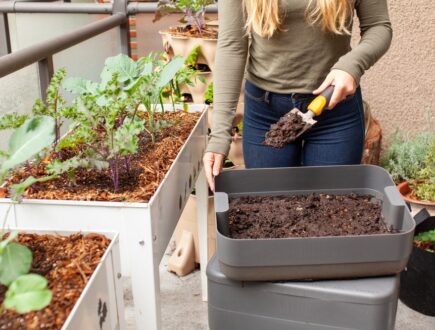








Comments (0)
There are no comments yet. Well then, what are you waiting for to
Be the first to write your comment!inaugurate this pretty page?
Do you have some comments?